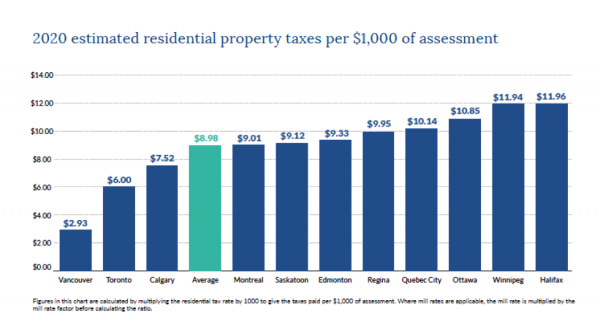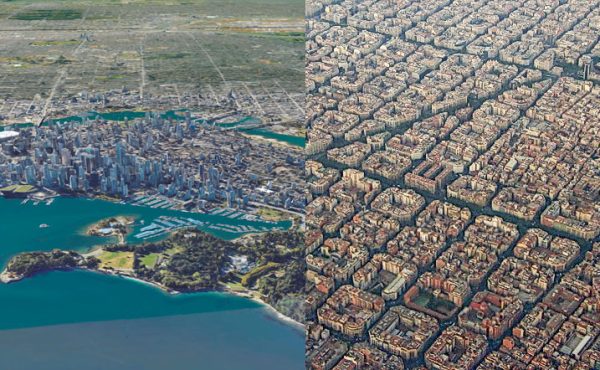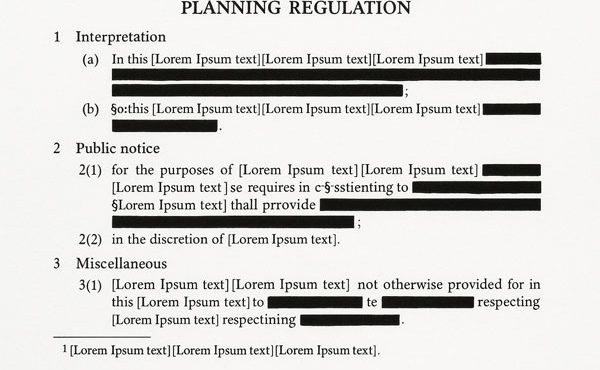
Vancouver’s housing market is obscenely broken. Time has run out for those left behind who have inherited a cruel reality where housing costs steal their future lived experience. Who can blame their advocacy? It’s time to share by rethinking how we “serve and protect” to reverse the exploitation that got us here.
A Short Recap
Current for-profit approaches to address affordability through re-zoning are stuck in “Community Amenity Contributions (CAC) Purgatory”. Re-zonings require over-priced land assembly, with expensive underground parking and inefficient buildings with smaller units that constrain social contact. This ultimately requires elected officials to spend precious political capital in exchange for very little.
If CAC’s and Development Cost Levies (DCL’s) are waived, for-profit proposals do not pay their fair share in delivering local amenities. If they are not waived, the CAC/DCL’s add to a project’s bottom line demanding more revenue through higher purchase prices or rents. The city, hypocritically, continues its addiction to this revenue stream so that property taxes are kept to a minimum (by far the lowest for any major city in Canada as emphasized above), particularly for single-family homeowners who occupy more than half of Vancouver’s land area.
This means that rents and purchase prices are higher so that those who live in “Vancouver’s Worst Zoning” pay lower property taxes. This is what the current development system is imposing on those left behind. Stuck in CAC Purgatory emphasizes we are going about housing affordability the wrong way.
We’re also in love with our “greenness”. Really? We’re not all that compact and our system rewards big, expensive, environmentally destructive concrete projects. Is it worth having EV charging stations for Teslas that can never be driven because renters and purchasers must pay for unused parking stalls! WTF?
Our way forward is through sharing.
We need to reboot our current zoning so that it more productively “manages” land costs by tying increased density allowances directly to secured affordability. This means that all of the excessive re-zoning costs would not be passed on to the purchaser or renter, and, the introduction of smaller, alternative building forms that are less expensive and easier to deliver. We are at the regulatory crossroads of managing affordability with only a few tools left to control the cost of land so housing is better aligned with local incomes.
Elected officials must now choose between the current for-profit, market-driven approaches of “supply, supply, supply” or refining current zoning to deliver new affordable housing solutions. There are institutionalized biases to achieving this but I remain optimistic that we can regulate more “elegantly” to meet all stakeholder interests while solving our housing crises. Our goal is a quintuple word score win that achieves greater outcomes than solutions that only address singular interests in isolation.
Let’s solve for resilience.
The “Shareholders”
All city-building stakeholders can proactively contribute to a regulatory shift that can expand non-market housing opportunities. Below are the key players, including a brief overview of how each can share. I understand if this seems too hard, even counter-intuitive, but I believe it’s possible to co-develop new ideas while addressing multiple interests. We need thoughtful, proactive leadership to spark the right conversations that address affordability holistically including meaningful input from Indigenous People.
The following “shareholders” deserve particular attention due to their distinctive roles as housing affordability influencers:
- Single Family Home Owners
- Housing Advocates
- The Neighborhoods
- Developers
- Elected Officials
How Each Can Share
For starters, instead of “calling these groups out”, let’s “call them in”. Here is how everyone can play nicely so that others have a future in our city.
Single Family Home Owners
Single-family homeowners have been gifted unearned paper wealth because they were born at the right time. OK, good for them (this cohort includes me). A moral question to the Single-Family Folks: how about directly, or indirectly, sharing some of your unproductive (read “hoarded”), unearned land equity with those left behind? True happiness comes from sharing, right?
What does your sharing look like?
Sharing means making peace with larger buildings next door. But this should not be expensive 5-6 storey apartment buildings requiring land assembly. It should not mean underground parking that current by-laws compel. Below is a provocative comparison of an approved market rental project at 1535 Grant (currently “The Standard” promoted by current regulations) with the Urbanarium’s Missing Middle Competition winner on Pandora Street in Burnaby. We’ll need 4 Pandoras to match Grant’s site area and frontage:
One Of These Projects Is Not Like The Other
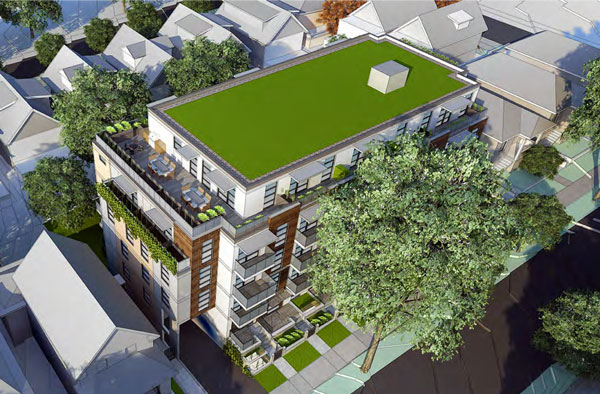
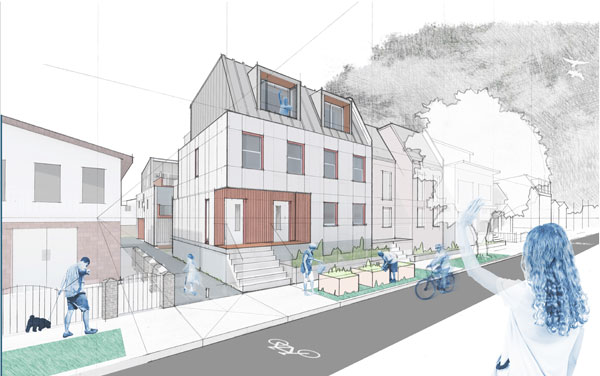
Let’s compare!
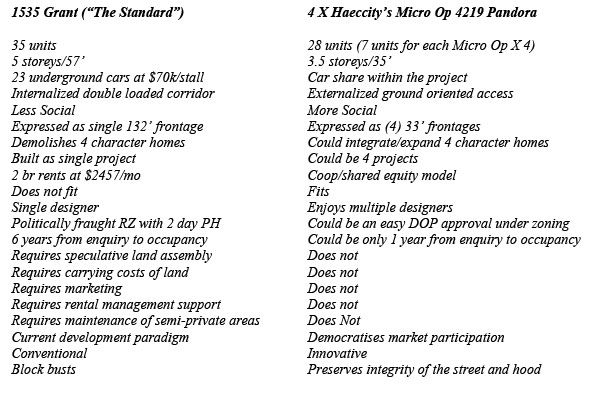 And these “1535 Grant” apartment rental projects are sprouting up everywhere! I don’t blame the architects or their developer clients. Most are well-designed and achieve what the market rental policies anticipate. I understand that the city considers these buildings as “Missing Middle”….but no, they aren’t. Not even close. They are at the lower end of the “mid-rise” category.
And these “1535 Grant” apartment rental projects are sprouting up everywhere! I don’t blame the architects or their developer clients. Most are well-designed and achieve what the market rental policies anticipate. I understand that the city considers these buildings as “Missing Middle”….but no, they aren’t. Not even close. They are at the lower end of the “mid-rise” category.
True, missing middle housing is of a scale much more compatible with single-family zoning. True, missing middle housing that productively delivers affordable housing, is contextually sensitive. This is emphasized by the comparison above that demonstrates a similar housing yield in four smaller buildings on existing sites when compared to a much larger apartment building on an assembled site.
Politicians and single-family neighbourhoods must consider smaller, dense projects at 3.5 storeys, as an alternative to large apartment buildings next door. I consider this strategy to be the “sweet spot” that can accommodate a variety of innovative residential forms that more productively deliver mixed tenure affordability while fitting in.
These truly Missing Middle forms are not currently approvable under any zoning and can deliver 100% net to gross floor area efficiency. This means no interior circulation, exit stairs, and elevators for end purchasers or renters to pay for.
Sharing means making peace with adjacent properties having reduced setbacks from the front street/sidewalk. Innovative housing, that does not require land assembly, needs greater site coverage to be economically productive, and existing single-family housing is “over yarded” (apologies to all gardeners). Greater site coverage will produce substantially higher unit counts that could be doubled up to 6—even tripled to 9 or 10—on narrow lots without producing large buildings.
Sharing also means supporting residential sub-division towards smaller housing forms that more efficiently use land towards greater affordability. Sharing means not complaining about approvals that do not include parking.
Is car ownership still a thing?
Time to put away the past, buy e-bikes and e-scooters, while introducing greater walkability to local services under a City-Wide Plan. Lanes are for playing, making, growing, selling, and partying. Time to have more fun in our lanes! I’m sure the upcoming Urbanarium’s Mixing Middle Competition will offer some great ideas!
Single-Family Homeowners have so much to share. They can embrace a new market that generates more productive housing free from current density, setbacks, site coverage and parking constraints. Their sharing will liberate land equity while strengthening the neighborhood with new residents.
Housing Advocates
I’m with those who lead tours of Vancouver’s Worst Zoning. I worry that you continue to argue against your own interests by supporting housing policies borne from less than altruistic, for-profit, values. This essay offers an alternative perspective that better serves your interests. You deserve better….and in deserving better, your advocacy will strengthen neighborhoods.
Housing Advocates left behind should realize that current re-zoning policies do not produce lower housing prices. Instead, you pay extra for what is not essential. Better, cheaper, faster housing will also strengthen resilience. It will bring more patronage to the mom-and-pop shops. More inter-generational support. Simply put: there are more folks to share!
Your hard-earned dollars should be spent on stuff that is important. This is within grasp by motivating smaller, intensive, projects under a more evolved existing zoning.
The Neighborhoods
The recent joint Federal-Provincial report that tackled housing affordability in BC found that “community–based public opposition” is a barrier to creating new housing supply. A deeper look by responsible media, or the industry-biased panel itself, will reveal that local opposition to housing is a much more complex issue. Productive “design consultation” will always generate thoughtful ideas for neighborhood consideration. We have simply stopped doing this.
I have had the privilege to work with many groups who are dismissed as NIMBY’s. These engaged neighbors want better housing solutions than offered under current policies. They are not NIMBY’s. They are not against housing. They are for more intelligent solutions and want to share.
I know of recent community-initiated proposals that offered better ideas than city hall, and the industry, with the aim of better, faster and cheaper housing. These include an alternative development strategy for 4th and Balaclava, a less impactful form of development adjacent to the Vancouver Hospice Society, and False Creek South’s Campus of Care that will triple the number of units for the homeless while freeing up larger homes of empty nesters so that families with children can occupy.
These proactive neighborhood groups, and others, are not represented in the joint report’s findings. Continued industry-biased media attention, that simplistically suggests NIMBY’s are “the problem”, is lazy journalism.
Vancouver’s recent rental housing policies—Short Term Incentives for Rental (STIR)/Rental 100/Moderate Income Rental Housing Pilot Program (MIRHPP)—cast aside recently approved community plans borne of the generous time contributed by the community.
I’m confident that adjusted zoning schedules will deliver affordable housing tied to lower incomes while retaining the scale of established neighborhoods. Current policies are contextually insensitive hence the predictable push back from those who invested countless hours into their Community Plans approved by previous councils. These Plans were also intended to ensure certainty, not as a starting point for future councils and their staff to amp up. These neighborhoods have been screwed: their generous time gifts are long forgotten.
The most vivid example of such abuse is the pending re-zoning proposal for the Safeway site at Broadway and Commercial. This proposal dramatically exceeds density, form, scale, and height commitments made by a previous (development-centric) City Council for this important site.
Who can blame the community backlash—such as No MegaTowers at Safeway—when City Hall invites such a dramatic departure from recently created policies, borne of their own “consultation band-aid”—The Citizens Assembly.
It’s worth repeating that we have a discretionary system, that creates tremendous wealth for the market, because of the contributions made by the local community that are necessary to “politically rationalize” the release of market value.
It’s horrible, and shameful, when these hard-fought policies are simply cast aside.
Developers
Developers, supported by their design professionals and the construction trades, built Vancouver.
Our discretionary zoning system has enabled a local market that has been productive for many decades, with predictable profit-taking for all involved. This includes those who assemble land, those that market land and respective projects, as well as those that navigate City Hall’s approval processes while liaising with the public, and the financial institutions and investors who lend. Everyone in the development food chain, including the bureaucrats, have done well by our system. And everyone involved will continue to do well given the prospect for growth, and enabling policies already on the books.
We must collectively acknowledge that such relatively “easy money” is now coming at the expense of those left behind.
The answer is to expand the market in a way that invites lay owners, who are land-rich, to become financial partners that co-develop new, more affordable housing. Those currently building single-family houses, laneways, duplexes and infills will easily scale up to buildings that could double existing zoned densities for small sites.
These projects will produce better housing through adjusted zoning that enables built-up land equity to be productively leveraged. There are numerous combinations of site size, built form, and viable tenure mixing that the market could propose. My personal conversations with developers of larger projects indicate an interest to “scale down” and deliver smaller, more intensive projects, especially under a streamlined approvals process.
This expanded market—relying on existing land ownership, or perhaps consolidating with an adjacent neighbor—would protect equity from capital gains triggered when land changes hands. Such taxation, along with the cost of land itself, need not be passed on to the end purchaser or renter which happens under current policies. This expanded market would eliminate non-value-added soft costs such as marketing programs as well as the speculative and legal costs of land assembly.
Furthermore, this new market would introduce prospects for family legacy, and financial security with retained ownership paying dividends to the estate over time, while contributing affordable housing. This would strengthen social resilience through inter-generational support.
This expanded market, enabled by zoning changes discussed later in Part 4, would liberate latent, unproductive land equity hoarded under single-family zoning while growing local capacities for the construction trades and designers.
Current lending institutions, such as Vancity, have already developed lending programs for small housing which could be tailored to serve this expanded market. And finally, this market could liberate housing innovation by pre-approving building form and associated tenure.
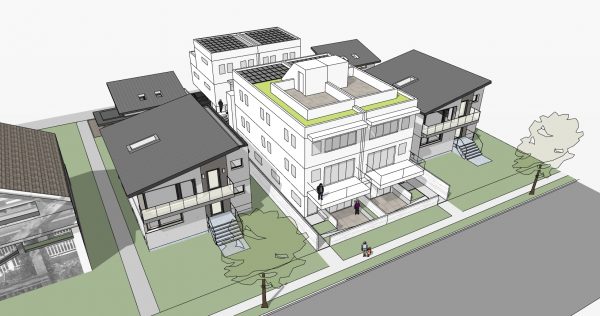
Design and Image Credit: Lanefab Design/Build
Development industry organizations, and their lobbyists, should embrace this new market that is viable without compromising the on-going development of larger projects currently possible.
Elected Officials
Resilience is the most important political legacy of our current elected officials.
Mayor and Council have an opportunity to deliver a truly more compact city in a way that expands and strengthens local communities towards shared resiliency. Apartment buildings are less social than equally productive alternative building forms that have more potential for larger family-oriented units, as well as private and communal open space.
Increased social capital, through building forms that promote sharing, can be re-invested on-site (gardening, daycares, beer and winemaking, sharing tools and bicycles). And sharing builds community (False Creek South buildings show us how to do this). Multiple on-site communities in close proximity will produce even greater social resilience through productive networking (the enclaves of False Creek South also show us the way).
The Urban Design diagram below shows the inherent potential for Vancouver to evolve into a more intimate, interconnected system of unique micro-communities that will enhance resiliency through networking and sharing, especially when the power goes off!
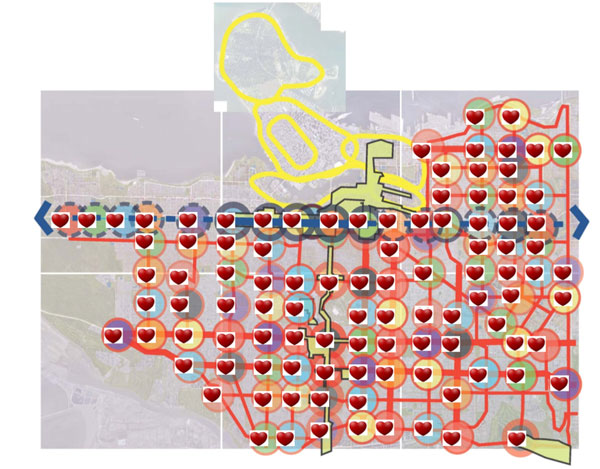
I’ve argued that the City contributes to the lack of affordability by “printing money” (demanding Community Amenity Contributions) through the re-zoning process. Obscenely high condo prices, and for-profit market rents, have no relationship to local income and have become “accepted” as the only alternatives available to young people.
Is the city afraid to transcend our out-of-date approval system to better reflect societal needs by recalibrating zoning intention and allowances? Is there a fresh approach to discretionary incentives that could be codified to motivate social outcomes with less emphasis on inconsequential architectural details while still producing thoughtful form and scale?
The answer is yes.
Yes means a substantively different approach to parking requirements. The Vancouver Parking By-law has become the de facto Urban Design Plan for the city: everything we see above ground is effectively extruded vertically from efficient parking structures below. The by-law, therefore, promotes land assembly, towards an underground economy of scale required to meet regulatory obligations……again at $70k/stall! We need to stop such parking madness, with this cost directly passed on to the renter or purchaser.
Alternatively, let’s be more thoughtful and acknowledge necessary parking for commercial operations and visitors, then let the market prevail. Developers can choose to deliver on affordability, while generating profitable revenue, or have their market-driven parking counted in Floor Space Ratio (FSR) that represents the amount a developer can build as a multiple of the site area.
Let’s adjust the parking by-law to easily allow for smaller site compliance without land assembly. Let’s acknowledge e-vehicle car sharing among the on-site community as an intelligent approach to using the land.
Yes also means new allowances for all residential zones, including lowered basic floor area limits in contrast to higher discretionary potential (more density and height) that provides the Director of Planning more zoning leverage to deliver affordability.
Codified housing obligations, that are secured for mixed tenure scenarios, can be introduced into zoning schedules to more responsibly award market value. We already know how to do this downtown. Let’s modify these tools so that they are appropriately calibrated to the outer neighborhoods to reinforce contextual fit. And, most importantly, let’s stabilize land costs by stopping the re-zoning madness.
In addition to single-family zoning, a good case study is False Creek South (FCS): a neighbourhood that continues to model the “art of community”. A refresh of their deceptively dense enclaves, combined with aggressive development of large-scale intact sites at the bridgeheads—including surgical development of the leftover “in-between” sites—will demonstrate how other neighborhoods can thoughtfully transform within their own particular context. Vancouver has much to learn and apply from FCS: something we’ll look more closely at in Part 5.
City staff has yet to embrace FCS’s thoughtful Community-Based Community Plan that has declared unwavering support for intelligent growth, with staff now choosing to move the political conversation behind closed doors. What other neighborhoods are responsibly embracing intensification like False Creek South? City Hall has an opportunity to demonstrate trust as it considers its future.
How will they respond, and what will this say for the City-Wide Plan that must also, fundamentally, be an expression of trust? How could such trust manifest to solve our housing crises in established neighborhoods.
Leadership is needed that recognizes how to thoughtfully consider False Creek South’s future.
Shared Sharing
Sharing means recognizing that there are “elegant” relationships between economic, environmental, and social aspirations. It means shared awareness of how productive city-building works, while co-discovering, and formalizing, new policy and implementation tools that reflect contemporary values and needs. This starts with new ideas that support those left behind in our housing market while ensuring a prosperous future for Indigenous people, and for our neighborhoods.
Multiple word score strategies are not conceived in presumptuous, pre-mature, and isolated corporate silos. Innovation does not reveal itself when solving for only one aspect of city-making. Asking the right questions, at the right time, in a way that fosters meaningful discourse reveals new approaches currently not recognized because of hard-wired, outdated methods and systems of city-making.
A creative approach to planning and design, if properly conducted, can solve for resilience in a way that strengthens the success of more individual interests. Bonafide Urban Design engagement is the most productive way to reveal shared potential. In fact, it is easier to solve “wicked” challenges by applying creative design methods that holistically bring together multiple interests through intensive and aspirational discourse.
The current piecemeal approach to solving affordable housing, independent of the City-Wide Plan process and honorable public engagement, is dangerous. New, innovative housing solutions are achievable through thoughtful consultation and education with the shareholders. In this context, “quick start” programs, motivated by political shortsightedness, may preclude “better, faster, cheaper” housing ideas.
As you know, what keeps me up at night is the prospect of a Vancouver future that defaults entirely to a for-profit paradigm that promotes expensive land assembly to accommodate projects of a downtown scale for the outer neighbourhoods.
Neighborhoods outside the downtown deserve their own set of rules – a way of intensifying that reinforces urban fabric, patterns and local identity including the scale of buildings. We can do this and still deliver affordability.
Yet, we are well down the implementation road to imposing overly scaled buildings (Grant Street) onto these underdeveloped, mostly single-family, contexts. Well-intentioned policies, conceived in isolation of larger, more inclusive input, will continue to spend political capital and exhaust staff while delivering housing that is not very good, fast, or cheap. Urban Design is ignored in the process.
For the outer neighborhoods, there is a better way.
These neighbourhoods have unique attributes, with complex stakeholder interests, and are poised to build resiliency, while delivering a large amount of non-market and other tenured housing.
It is time to go small.
Such a new market will prosper immediately.
We’ll explore how new zoning could motivate such a market in tomorrow’s Part 4: Zoning for Resiliency.
***
Related articles, in sequence:
- You Forgot About Me! – Part 1
- You Forgot About Me! – Part 2
- Zoning Must Evolve – Introduction
- Zoning Must Evolve – Part 1
- Zoning Must Evolve – Part 2
- Zoning Must Evolve – Part 3
- Zoning Must Evolve – Part 4
- Zoning Must Evolve – Part 5
- You Forgot About Me! – Part 3
**
Scot Hein is a retired architect, former senior urban designer at the City of Vancouver and the University of British Columbia. He is an adjunct professor of Urban Design at UBC, lecturer at Simon Fraser University and founding board member of the Urbanarium.

